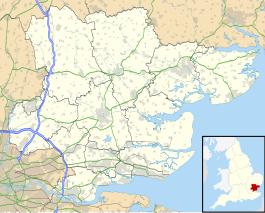Buckhurst Hill tube station
| Buckhurst Hill |
|
|---|---|

Station entrance
|
|
|
Location of Buckhurst Hill in Essex
|
|
| Location | Buckhurst Hill |
| Local authority | District of Epping Forest |
| Number of platforms | 2 |
| Fare zone | 5 |
| London Underground annual entry and exit | |
| 2012 |
|
| 2013 |
|
| 2014 |
|
| 2015 |
|
| Key dates | |
| 22 August 1856 | Opened |
| 1892 | resited |
| 6 January 1966 | Goods yard closed |
| Other information | |
| Lists of stations | |
| WGS84 | 51°37′36″N 0°02′49″E / 51.62666°N 0.04694°ECoordinates: 51°37′36″N 0°02′49″E / 51.62666°N 0.04694°E |
|
|
|
Buckhurst Hill is a London Underground station, in the Epping Forest district of Essex. It is served by the Central line and is between Woodford and Loughton. It is the larger of the two Underground stations in the town of Buckhurst Hill, with Roding Valley station being the smaller.
The station opened on 22 August 1856 as part of the Eastern Counties Railway branch from London to Loughton. It originally had staggered platforms, with the main buildings on the down side (tracks heading away from London). The 1856 station house survives to the south of the present platforms, but most of the present station dates from 1892, when the entrance was moved to Victoria Road. The building is similar to that at Billericay. Both were designed by W. N. Ashbee, the chief architect of the Great Eastern Railway, of which the station was a part, which was, from 1923, to become part of the London & North Eastern Railway.
The station was transferred to London Underground ownership as part of the New Works Programme, 1935-1940 scheme that saw the electrification of the branch to form part of the Central line. This occurred on 21 November 1948. The station maintains its late Victorian ambiance to a surprising extent. There are disused exit/entrances to the south of the station that date from the transfer to the Underground; these gave direct access to Lower Queens Road and Queens Road. The pedestrian underpass between these two roads is still open. These exits were closed permanently in the 1980s, saving the expense of installing automatic ticket barriers on these additional two entries.
...
Wikipedia

